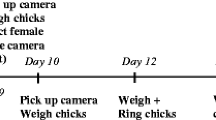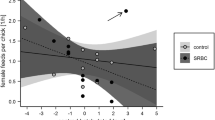Abstract
What is the relative contribution of genetic and various environmental factors to variation in the ability to mount an immune response? We measured antibody responsiveness to diphtheria-tetanus vaccine during the winter in free-ranging blue tits with a known nestling history to investigate (1) if nutritional status during the nestling stage has persistent effects on an individual's immune defence and (2) if immune responsiveness is heritable. There was no correlation between nutritional status during the nestling phase (measured as size-corrected body mass day 14 post-hatch) and antibody responsiveness as an adult. On the other hand, the heritability of responsiveness to diphtheria and tetanus, as estimated by parent-offspring regression, was 0.21±0.51 and 1.21±0.40 SE, respectively. Thus, while there was little evidence that natural variation in antibody responsiveness to these antigens reflected nutritional conditions during early life, responsiveness to at least one of the antigens (tetanus) had a strong genetic component.

Similar content being viewed by others
References
Alatalo RV, Gustafsson L, Lundberg A (1990) Phenotypic selection on heritable size traits: environmental variance and genetic response. Am Nat 135:464–471
Alonso-Alvarez C, Tella JL (2001) Effects of experimental food restriction and body-mass changes on the avian T-cell-mediated immune response. Can J Zool 79:101–105
Boa-Amponsem K, Dunnington EA, Siegel PB (1997) Genetic architecture of antibody responses of chickens to sheep red blood cells. J Anim Breed Genet 114:443–449
Boulinier T, Sorci G, Monnat JY, Danchin E (1997) Parent-offspring regression suggests heritable susceptibility to ectoparasites in a natural population of kittiwake Rissa tridactyla. J Evol Biol 10:77–85
Brinkhof MWG, Heeb P, Kolliker M, Richner H (1999) Immunocompetence of nestling great tits in relation to rearing environment and parentage. Proc R Soc Lond B 266:2315–2322
Brown ME (1996) Assessing body condition in birds. Curr Ornithol 13:67–135
Christe P, Møller AP, Saino N, de Lope F (2000) Genetic and environmental components of phenotypic variation in immune response and body size of a colonial bird, Delichon urbica (the house martin). Heredity 85:75–83
Cichon M, Dubiec A, Chadzinska M (2001) The effect of elevated reproductive effort on humoral immune function in collared flycatcher females. Acta Oecol 22:71–76
Deerenberg C, Apanius V, Daan S, Bos N (1997) Reproductive effort decreases antibody responsiveness. Proc R Soc Lond B 264:1021–1029
Falconer D, Mackay T (1996) Introduction to quantitative genetics. Longman, Essex, UK
García-Berthou E (2001) On the misuse of residuals in ecology: testing regression vs the analysis of covariance. J Anim Ecol 70:708–711
Hasselquist D, Marsh JA, Sherman PW, Wingfield JC (1999) Is avian humoral immunocompetence suppressed by testosterone? Behav Ecol Sociobiol 45:167–175
Klasing K, Leshchinsky TV (1998) Functions, costs, and benefits of the immune system during development and growth. In: Adams NJ, Slotow RH (eds). Proc Int Ornithol Congr 22:2817–2835
Lindén M, Gustafsson L, Pärt T (1992) Selection on fledging mass in the collared flycatcher and the great tit. Am Nat 73:336–343
Lindström J (1999) Early development and fitness in birds and mammals. Trends Ecol Evol 14:343–348
Metcalfe NB, Monaghan P (2001) Compensation for a bad start: grow now, pay later? Trends Ecol Evol 16:254–260
Møller AP (1990) Effects of a hematophagous mite on the barn swallow (Hirundo rustica) - a test of the Hamilton and Zuk hypothesis. Evolution 44:771–784
Myrvik Q (1988) Nutrition and immunology. In: Shils MS, Young VR (eds). Modern nutrition in health and disease. Lea and Febiger, Philadelphia, pp 585–616
Nordling D, Andersson MS, Zohari S, Gustafsson L (1998) Reproductive effort reduces specific immune response and parasite resistance. Proc R Soc Lond B 265:1291–1298
Noordwijk A van (1986) Two-stage selection in which the first stage only reduces the environmental variation in body size in the great tit. In: Oullet H (ed) Proc.Int Ornithol Congr 19:1408–1415
Ohlsson T, Smith HG, Råberg L, Hasselquist D (2002) Pheasant sexual ornaments reflect nutritional conditions during early growth. Proc R Soc Lond B 269:21–27
Parmentier HK, Nieuwland MGB, Rijke E, De Vries Reilingh G, Schrama JW (1996) Divergent antibody responses to vaccines and divergent body weights of chicken lines selected for high and low humoral responsiveness to sheep red blood cells. Avian Dis 40:634–644
Price T, Kirkpatrick M, Arnold SJ (1988) Directional selection and the evolution of breeding date in birds. Science 240:798–799
Råberg L (2002) Costs in the ecology and evolution of the vertebrate immune system. PhD dissertation, Lund University, Sweden
Råberg L, Stjernman M (2003) Natural selection on immune responsiveness in blue tits. Evolution (in press)
Roulin A, Jungi TW, Pfister H, Dijkstra C (2000) Female barn owls (Tyto alba) advertise good genes. Proc R Soc Lond B 267:937–941
Saino N, Incagli M, Martinelli R, Møller AP (2002) Immune response of male barn swallows in relation to parental effort, corticosterone plasma levels, and sexual ornamentation. Behav Ecol 13:169–174
Smith JA, Wilson K, Pilkington JG, Pemberton JM (1999) Heritable variation in resistance to gastro-intestinal nematodes in an unmanaged mammal population. Proc R Soc Lond B 266:1283–1290
Svensson E, Råberg L, Koch C, Hasselquist D (1998) Energetic stress, immunosuppression and the costs of an antibody response. Funct Ecol 12:912–919
Svensson E, Sinervo B, Comendant T (2001) Density-dependent competition and selection on immune function in genetic lizard morphs. Proc Natl Acad Sci USA 98:12561–12565
Svensson L (1992) Identification guide to European passerines. Svensson, Stockholm, Sweden.
Tella JL, Bortolotti GR, Forero MG, Dawson RD (2000) Environmental and genetic variation in T-cell-mediated immune response of fledgling American kestrels. Oecologia 123:453–459
Acknowledgements
We thank Claus Koch (Statens Serum Institut, Copenhagen) for producing the rabbit-anti-starling antiserum and J. Grindstaff, J.-Å. Nilsson and two anonymous referees for comments on the manuscript. This work was supported by Lunds Djurskyddsfond and the Royal Swedish Academy of Science (to L.R.) and SJFR/Formas, Carl Tryggers Stiftelse, and Crafoordska Stiftelsen (to D.H.). The study was approved by the ethical committee for animal research Malmö/Lund.
Author information
Authors and Affiliations
Corresponding author
Rights and permissions
About this article
Cite this article
Råberg, L., Stjernman, M. & Hasselquist, D. Immune responsiveness in adult blue tits: heritability and effects of nutritional status during ontogeny. Oecologia 136, 360–364 (2003). https://doi.org/10.1007/s00442-003-1287-3
Received:
Accepted:
Published:
Issue Date:
DOI: https://doi.org/10.1007/s00442-003-1287-3




